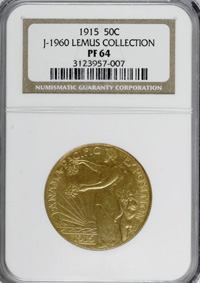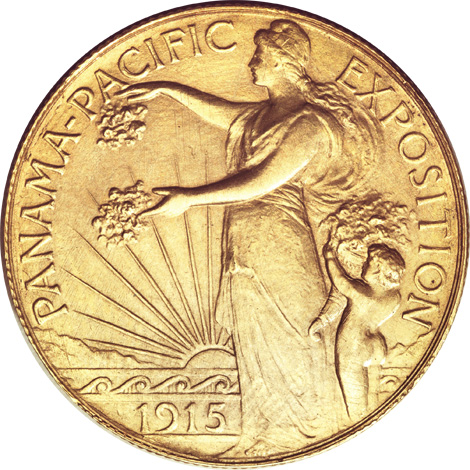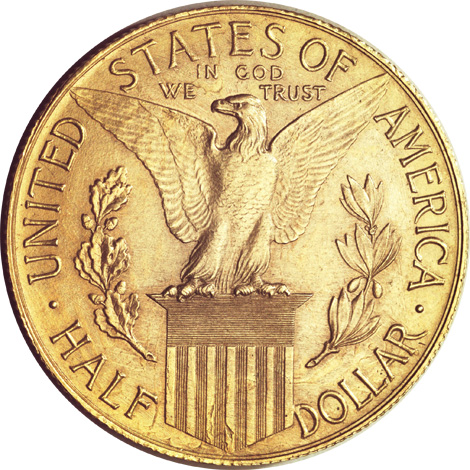Editor’s Note: The following description is taken from the Heritage auction listing.


 Design: The design is the same as the regular-issue 1915-S Panama-Pacific commemorative half, but lacking the normal S mintmark. Struck in gold with a reeded edge.
Design: The design is the same as the regular-issue 1915-S Panama-Pacific commemorative half, but lacking the normal S mintmark. Struck in gold with a reeded edge.
 Commentary: Other S-less Panama-Pacific half dollar patterns are also known in silver and copper. These extremely rare patterns were clearly clandestine strikes, produced at the Philadelphia Mint before mintmark punches were applied to the working dies. There are two known examples of the gold half dollar, both struck on cut-down, struck Saint-Gaudens double eagle coins. Similar examples are known of the 1915 Panama-Pacific gold dollar and of the round and octagonal fifty dollar pieces, all lacking the S mintmark. The website USPatterns.com comments of the pieces, “These could be die trials but it seems that they were really struck for profit.”
Commentary: Other S-less Panama-Pacific half dollar patterns are also known in silver and copper. These extremely rare patterns were clearly clandestine strikes, produced at the Philadelphia Mint before mintmark punches were applied to the working dies. There are two known examples of the gold half dollar, both struck on cut-down, struck Saint-Gaudens double eagle coins. Similar examples are known of the 1915 Panama-Pacific gold dollar and of the round and octagonal fifty dollar pieces, all lacking the S mintmark. The website USPatterns.com comments of the pieces, “These could be die trials but it seems that they were really struck for profit.”
 Pollock comments in his United States Patterns and Related Issues:
Pollock comments in his United States Patterns and Related Issues:
 “Farran Zerbe, who was involved in the coining and distribution of the Panama-Pacific commemoratives in California, has been quoted by Walter Breen as saying that specimens ‘may have been struck as trial pieces at the Philadelphia Mint by the instructions of the Secretary of the Treasury, who was a coin collector.’ The Secretary of the Treasury at the time was W.G. McAdoo of New York, a name familiar to students of U.S. paper money.”
“Farran Zerbe, who was involved in the coining and distribution of the Panama-Pacific commemoratives in California, has been quoted by Walter Breen as saying that specimens ‘may have been struck as trial pieces at the Philadelphia Mint by the instructions of the Secretary of the Treasury, who was a coin collector.’ The Secretary of the Treasury at the time was W.G. McAdoo of New York, a name familiar to students of U.S. paper money.”
 Anthony Swiatek, in his Commemorative Coins of the United States (2001), writes much more unequivocally concerning the 1915 Pan-Pac half dollar, “Extremely rare trial pieces, made at the Philadelphia Mint, were struck without the S Mint mark. Two were created in gold, six in silver and four in copper for Treasury Secretary William Gibbs McAdoo--a coin collector!”
Anthony Swiatek, in his Commemorative Coins of the United States (2001), writes much more unequivocally concerning the 1915 Pan-Pac half dollar, “Extremely rare trial pieces, made at the Philadelphia Mint, were struck without the S Mint mark. Two were created in gold, six in silver and four in copper for Treasury Secretary William Gibbs McAdoo--a coin collector!”
 Physical Description: Further along, Pollock records his notes on the present specimen:
Physical Description: Further along, Pollock records his notes on the present specimen:
 “Careful examination of the Farouk-Norweb coin [the present coin, listed as No. 2 in the Census below] reveals planchet file marks and traces of an undertype, indicating that the half dollar dies were impressed on a cut-down $20 gold coin, which had been filed to remove high-relief details. This piece is remarkably thick: 2.4 mm at the edge versus 2.1 mm for a regular-issue Panama-Pacific half dollar.
“Careful examination of the Farouk-Norweb coin [the present coin, listed as No. 2 in the Census below] reveals planchet file marks and traces of an undertype, indicating that the half dollar dies were impressed on a cut-down $20 gold coin, which had been filed to remove high-relief details. This piece is remarkably thick: 2.4 mm at the edge versus 2.1 mm for a regular-issue Panama-Pacific half dollar.
 “The characteristics of the coin suggest that it was made clandestinely. Since the piece is overstruck instead of being made using a new planchet of normal thickness, it can be inferred that there was a desire on the part of the manufacturer that no mention of the piece be made in the bullion account books, and thus it may have been produced secretly at the Mint in the same manner as the 1913 Liberty nickel or the Class III 1804 dollar. The only other known example of the variety is reportedly also struck over a cut-down $20 gold piece.”
“The characteristics of the coin suggest that it was made clandestinely. Since the piece is overstruck instead of being made using a new planchet of normal thickness, it can be inferred that there was a desire on the part of the manufacturer that no mention of the piece be made in the bullion account books, and thus it may have been produced secretly at the Mint in the same manner as the 1913 Liberty nickel or the Class III 1804 dollar. The only other known example of the variety is reportedly also struck over a cut-down $20 gold piece.”
 The reverse die of the present specimen is rotated about 40 degrees counterclockwise from normal coin turn with respect to the obverse. In contrast, the Brand-Johnson-ANA specimen, No. 2 in the census which we auctioned in 2003, shows only a slight counterclockwise rotation, on the order of 10 percent. The reverse of this piece also shows considerable evidence of the remaining Saint-Gaudens double eagle obverse undertype on the reverse, as follows: In the central shield area and to the rim below and on either side, traces of Liberty, the peripheral stars, the rock, the gown outline, the ASG monogram, and portions of a date (possibly 1916) appear, the last seen beneath the AR of DOLLAR. The juncture of Liberty’s head, neck, and left (facing) arm appear under TAT and IN / WE. (See closeup photos.)
The reverse die of the present specimen is rotated about 40 degrees counterclockwise from normal coin turn with respect to the obverse. In contrast, the Brand-Johnson-ANA specimen, No. 2 in the census which we auctioned in 2003, shows only a slight counterclockwise rotation, on the order of 10 percent. The reverse of this piece also shows considerable evidence of the remaining Saint-Gaudens double eagle obverse undertype on the reverse, as follows: In the central shield area and to the rim below and on either side, traces of Liberty, the peripheral stars, the rock, the gown outline, the ASG monogram, and portions of a date (possibly 1916) appear, the last seen beneath the AR of DOLLAR. The juncture of Liberty’s head, neck, and left (facing) arm appear under TAT and IN / WE. (See closeup photos.)
 While the logical date to appear is, of course, 1915 rather than 1916, the last digit in the undertype date, while far from bold, appears tantalizingly to have a top loop that much more resembles a 6 than a 5. No trace of a mintmark appears above the date. This piece also has tremendous eye appeal, with generous luster radiating from yellow-gold surfaces that occasionally deepen to orange-gold.
While the logical date to appear is, of course, 1915 rather than 1916, the last digit in the undertype date, while far from bold, appears tantalizingly to have a top loop that much more resembles a 6 than a 5. No trace of a mintmark appears above the date. This piece also has tremendous eye appeal, with generous luster radiating from yellow-gold surfaces that occasionally deepen to orange-gold.
 This piece is fairly conclusive evidence that, contrary to the prevailing view, chicanery and profiteering at the Mint did not die out in the 19th century. Farran Zerbe’s reputation as a numismatic huckster is widely known, but others (possibly excluding Zerbe) may have been involved in the production of this piece--possibly some of the same personnel responsible for the 1913 Liberty nickels. An unparalleled opportunity for the numismatic researcher or collector of rare patterns.
This piece is fairly conclusive evidence that, contrary to the prevailing view, chicanery and profiteering at the Mint did not die out in the 19th century. Farran Zerbe’s reputation as a numismatic huckster is widely known, but others (possibly excluding Zerbe) may have been involved in the production of this piece--possibly some of the same personnel responsible for the 1913 Liberty nickels. An unparalleled opportunity for the numismatic researcher or collector of rare patterns.


Census:
Only two pieces are known.
1. Fred E. Olsen Collection (B. Max Mehl, 11/1944), lot 1769, which realized an astounding $4,250; King Farouk; Palace Collections of Egypt (Sotheby’s, 1954), lot 309; Norweb Collection (Bowers and Merena, 11/1988), lot 3307. The present specimen.
2. Virgil Brand; Burdette G. Johnson; Celina Coin Co.; A. Friedman; ANA (New England Rare Coin Auctions, 7/1979), lot 1365; Sound Beach Collection (Heritage, 11/2003), lot 11252, which brought $165,000.85; Southern Collection; Simpson Collection. PR64 NGC.
From The Lemus Collection, Queller Family Collection Part Two.

